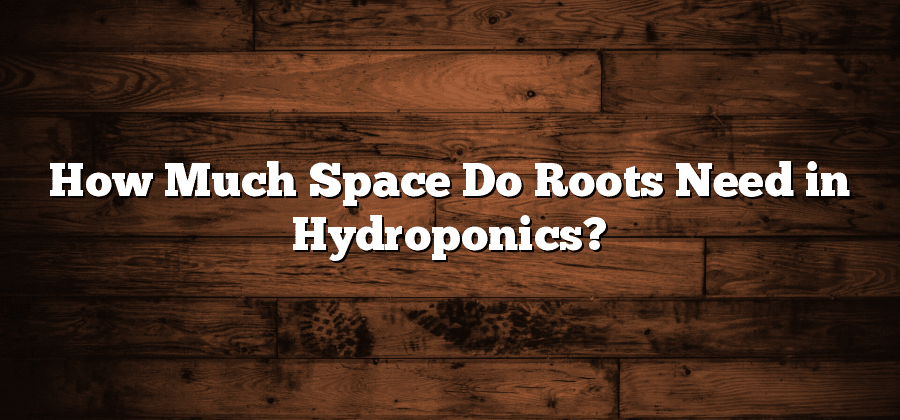Understanding the Root System in Hydroponics
The root system plays a vital role in hydroponics, as it is responsible for the absorption of water, nutrients, and oxygen necessary for plant growth. In traditional soil-based cultivation, roots tend to spread outwards in search of resources. However, in hydroponics, where plants are grown in a soilless medium, the root system is carefully managed to optimize their growth and performance.
One of the key advantages of hydroponics is the ability to control the root environment. This allows for precise adjustment of factors such as nutrient availability, moisture levels, and oxygen supply to meet the plant’s specific needs. Understanding the root system in hydroponics involves studying its structure, behavior, and requirements to ensure optimal growth and maximize yield. By delving into the intricacies of root development, hydroponic growers can make informed decisions regarding root space requirements, oxygenation techniques, and proper spacing for different hydroponic systems. With this knowledge, they can create ideal root conditions that contribute to healthy, thriving plants.
Factors Influencing Root Space Requirements
Proper root spacing is crucial for ensuring optimal growth and development in hydroponic systems. Various factors influence the root space requirements of plants in these setups. Firstly, the species of plant being grown plays a significant role. Different plants have varying root sizes and growth patterns, which directly impact the amount of space they require. For example, plants with extensive root systems, such as tomatoes or cucumbers, will need larger containers or more space compared to plants with smaller and shallower root systems like lettuce or herbs.
Another factor that affects root space requirements is the growth stage of the plant. Young seedlings with underdeveloped root systems will require less space initially but may need more room as they grow. Similarly, mature plants with well-established roots may outgrow their current space, necessitating larger containers or adjustments to the hydroponic system. It is essential to monitor and assess the growth of plants regularly to ensure they have adequate room for root expansion and avoid any negative impact on their overall health and productivity.
The Role of Oxygen in Root Development
One crucial factor in root development in hydroponics is the role of oxygen. Oxygen plays a vital role in the growth and health of plant roots as it is necessary for cellular respiration. In traditional soil-based gardening, oxygen is readily available in the air spaces within the soil. However, in hydroponics, where plants are grown without soil, ensuring a sufficient supply of oxygen to the roots becomes even more critical.
In hydroponic systems, oxygen is typically provided through the use of air pumps or aerators. These devices introduce air bubbles into the nutrient solution, increasing the oxygen levels available to the roots. Adequate oxygen levels stimulate root growth, increase nutrient uptake, and prevent the buildup of harmful anaerobic conditions that could lead to root rot or other diseases. By maintaining optimal levels of oxygen in the root zone, hydroponic gardeners can encourage healthy root development and ultimately promote vigorous plant growth.
Optimal Spacing for Different Hydroponic Systems
Hydroponics systems are designed to provide an optimal growing environment for plants, and one crucial factor to consider is the spacing between plants. The spacing requirements vary depending on the type of hydroponic system being used. In an ebb and flow system, for example, it is important to leave enough space between plants to allow for the ebb and flow of nutrient solution. This ensures that each plant receives an adequate amount of nutrients and prevents overcrowding, which can lead to poor air circulation and increased risk of disease.
Another important consideration is the type of plant being grown. Different plants have different root systems and therefore require different spacing. For plants with a shallow root system, such as lettuce or herbs, closer spacing can be used. This allows for more plants to be grown in a limited space. On the other hand, plants with deep root systems, like tomatoes or peppers, require more space between plants to allow for proper root development and nutrient absorption.
Overall, determining the optimal spacing for different hydroponic systems involves considering the type of system being used, as well as the specific needs of the plants being grown. By ensuring adequate space between plants, hydroponic growers can promote healthy root development, optimize nutrient uptake, and ultimately maximize the yield of their crops.
Importance of Proper Root Spacing for Nutrient Uptake
Proper root spacing is crucial for ensuring optimal nutrient uptake in hydroponic systems. The root system plays a vital role in absorbing water and essential nutrients from the growing medium or solution. When the roots are properly spaced, each individual root can have access to its fair share of nutrients, leading to healthier and more productive plants.
Insufficient root spacing can result in competition among the roots for nutrients, leading to stunted growth and nutrient deficiencies. When the roots are overcrowded, they can become tangled and restricted, hindering their ability to absorb nutrients efficiently. This can lead to nutrient imbalances, which can negatively impact plant health and overall yield.
On the other hand, providing adequate spacing between the roots allows for better nutrient distribution and uptake. Each root can spread out, allowing it to explore a larger volume of the growing medium or solution. This increased surface area enhances the root’s ability to come into contact with essential nutrients, enabling better absorption and utilization by the plants. Proper root spacing also facilitates the efficient exchange of gases, such as oxygen, which is crucial for healthy root development.
In conclusion, proper root spacing is vital for optimal nutrient uptake in hydroponic systems. It ensures that each root has access to the necessary nutrients, promoting healthy growth and productivity. By considering the specific spacing requirements of different hydroponic systems, growers can maximize nutrient absorption and create an environment conducive to plant growth.






